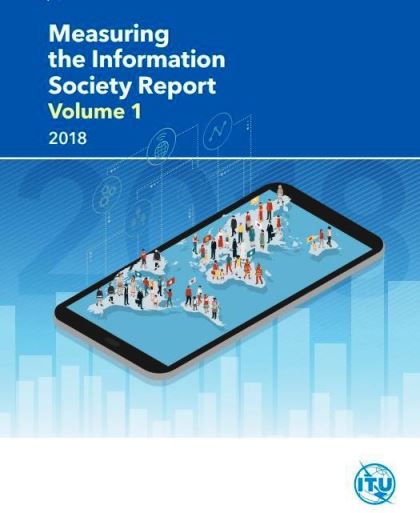More and more people worldwide have access to and are using the Internet. In fact about 51 per cent of the global population now access the internet, according to the ITU’s new Measuring the Information Society Report 2018, (MIS) released today. At the same time, ICT prices have dropped globally in the last decade. However, stronger information and communication technology (ICT) skills are needed to connect people everywhere, the report says. The ITU (International Telecommunications Union) is the global regulatory body for telecommunications.
-
Nigeria has achieved over 23 per cent broadband penetration and has over 80 million connected mobile Internet devices out of its over 145 million mobile telephony subscriptions. But access is pricey and sluggish –
Lack of or inadequate ICT skills are a major impediment for people to access the internet, the report notes adding that “some of the most populous countries worldwide, such as Bangladesh, China and India, stand out for having achieved mobile-cellular price baskets under USD 3 per month and feature among the top 20 countries with the lowest prices.” But in several developing economies, access and affordability remain a monstrous challenge.
Some of the top highlights in the Measuring the Information Society Report 2018, recognise that access is still lean and costly in countries like Nigeria, Ethiopia and several others in sub-Saharan Africa despite much progress in closing the bandwidth gaps. Nigeria has achieved over 23 per cent broadband penetration and has over 80 million connected mobile Internet devices out of its over 145 million mobile telephony subscriptions. But access is pricey and sluggish
The MIS Report also finds that improved ICT regulation and policy-making have played a pivotal role in creating the conditions for the reduction of prices, ensuring that part of the efficiency gains of higher ICT adoption are passed on to consumers.
“This year’s report shows how increased investment in broadband technologies is driving the global digital transformation and enabling more people to access a myriad of services at the click of a button,” says ITU Secretary-General Houlin Zhao. “At the just-concluded Plenipotentiary Conference (PP-18) held in Dubai, ITU Member States approved the four-year Strategic and Financial Plan, which includes a strong commitment to ITU’s statistical work. We will work together to build the ICT infrastructure and develop ICT skills necessary to foster inclusive economic growth, drive innovation and bridge the digital divide.”
“Now in its tenth year, ITU’s annual flagship report is widely recognized as a source of the world’s most reliable and impartial data and analysis on the state of global telecommunication/ICT sector,” says Brahima Sanou, Director of ITU’s Telecommunication Development Bureau. “Our analysis shows that digital technologies are fundamentally transforming the way we live and offering important opportunities for boosting economic growth, enhancing communications, improving energy efficiency, safeguarding the planet and improving people’s lives.”
Current state of ICTs
The report finds that there continues to be a general upward trend in the access to and use of ICTs. Most importantly, the world has crossed the halfway line in terms of Internet use, with 51.2 per cent of the world population using the Internet by the end of 2018.
ICT skills for the future
Lack of or inadequate ICT skills are a major impediment for people to access the Internet. ITU data and other cross-nationally comparative data sources show that there are considerable gaps across the board in the skills needed. A third of individuals lack basic digital skills, such as copying files or folders or using copy and paste tools; a mere 41 per cent have standard skills, such as installing or configuring software or using basic formulas on spreadsheets; and only 4 per cent are using specialist language to write computer programmes.
Download your copy of the report:
Computer users in developed countries seem to possess more ICT skills than users in developing countries. Lack of or inadequate ICT skills can seriously constrain the socio-economic development of developing countries and Least Developed Countries (LDCs).
The report suggests that inequalities in ICT use reflect other inequalities, such as those related to education, wealth and gender between the different regions of the world.
ICT revenue and investment trends
The report shows global retail telecommunication revenues reaching USD 1.7 trillion in 2016, representing 2.3 per cent of global gross domestic product (GDP). At the regional level, the importance of the sector in driving economic growth is clearly noticeable, especially in the developing world. Telecommunication revenues in 2016 represented on average 3 per cent of GDP in Africa and the Arab States, compared to 2 per cent in Asia and the Pacific and the Americas (excluding the United States and Canada), and less than 2 per cent in the CIS and Europe.
Fixed-line revenue represented half of telecommunication revenues generated in 2016 worldwide. Globally, mobile revenues declined by 7 per cent between 2014 and 2016, from USD 924 billion in 2014 to USD 859 billion in 2016. The report finds that mobile revenue growth is impacted by the uptake in services that run “over-the-top” (OTTs) of existing telecommunications infrastructure and that the success of IP-messaging apps is often to the detriment of traditional text usage and the associated revenue. It is also notes that the ICT sector is characterized by large infrastructure investments, with growth in telecommunication capital expenditure driven largely by data demand and use in developing economies.
ICT PRICE TRENDS
The report highlights that ICT prices have dropped globally in the last decade in parallel with the increase in access and use of ICT services. Fixed-broadband services recorded the largest price drop of all ICT services. Mobile-cellular prices also maintained a steady downward trend in the period 2008–2017, in line with the continuous increase in mobile-cellular penetration. Improved ICT regulation and policy-making have played a pivotal role in creating the conditions for the reduction of prices seen in the period 2008–2017, ensuring that the efficiency gains of higher ICT adoption are partly passed on to customers.
LEARN MORE: ITU’s approach to digital inclusion of all
Some of the most populous countries worldwide, such as Bangladesh, China and India, stand out for having achieved mobile-cellular price baskets under USD 3 per month and feature among the top 20 countries with the lowest prices. A number of LDCs, including Bhutan, Ethiopia, Myanmar, Nepal and South Sudan, also offer prices below USD 3 per month.
Almost all developed countries had computer-based mobile broadband prices corresponding to less than 2 per cent of gross national income (GNI) per capita. The price of an entry-level fixed-broadband plan significantly decreased worldwide in the last decade, from more than USD 40 per month on average in 2008 to USD 25 per month in 2017.































